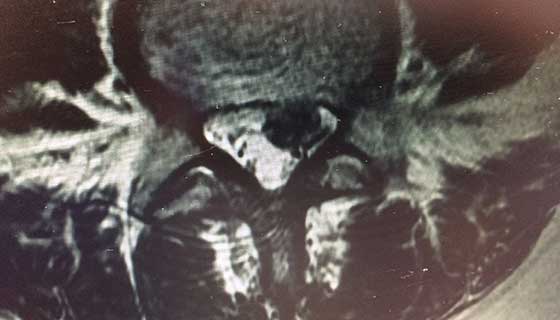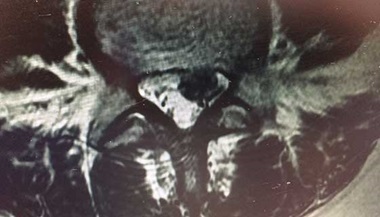Degenerative Disc Disease
What is degenerative disc disease?
One of the more unfortunate aspects of getting older is that your joints begin to wear out, oftentimes for no good reason. This wear and tear of the joints is not only common in the knees and the hips but also in the spine. The exact reason why the joints of the spine begin to wear out is not known and may be a combination of factors, such as doing a lot of lifting, having a family history of spine problems or having an injury to the spine. This wear and tear is a form of arthritis, which is where the cartilage in the spine joints begins to wear out. Regardless of the cause, it is well known that arthritis of the spine often increases with increasing maturity for no reason that can be identified.
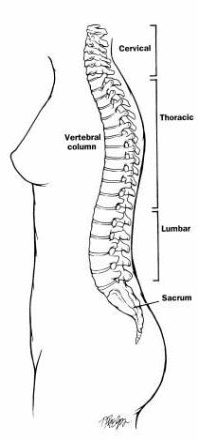
What are the signs of arthritis of the spine?
Most of the time when there is a little arthritis in the spine, the affected person never knows that it has developed. Sometimes the arthritis can be fairly severe and still have no symptoms. When arthritis of the neck becomes a problem, the signs can be pain in the neck and occasionally in the shoulder blades, into the shoulders and down the arm to the hand. When the pain is localized to the neck and the muscles next to the neck (the trapezius muscles), arthritis is usually causing the problem. Sometimes the neck gets irritated enough that the nerves become involved, and when that happens there may be pain that radiates down the arm to the wrist or fingers. Another sign of nerve involvement is tingling and numbness (called paresthesia) in the arm or fingers. Often the tingling and numbness will come and go and generally will not last. However, as the nerves become more involved and damaged, the tingling and numbness will remain. The nerves also make the muscles work, so if you notice muscle weakness or loss of strength, then the nerve damage is enough that you should seek medical attention right away. If the numbness and weakness are progressively getting worse, you should see your physician right away. Rarely arthritis in the neck can be bad enough to start to affect the nerves in the legs, so if you develop weakness in the legs, difficulty walking or trouble with your bowels or bladder, you should notify your physician and be evaluated right away. Most of the time arthritis in the spine is mild and emergency evaluation and treatment is not needed. Arthritis in the low back has similar symptoms and can cause pain in the back and sometimes into the buttocks. Sometimes the pain can radiate into the thighs, and if it does then it could indicate involvement of the nerves. The guidelines for symptoms of tingling, numbness and weakness are the same in the low back and lower extremities as they are for the neck (in the previous paragraph).
Why does arthritis cause these symptoms?
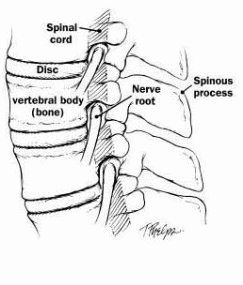
The spine in your body is divided roughly into three regions (Figure 1). The region in your neck area is the cervical spine, the region in your chest is the thoracic spine and the region in your low back is the lumbar spine. The spine is made up of bones, called the vertebrae, and soft spacers between the bones called discs (Figure 2). The vertebrae are made of bone, which is hard and gives the spine rigidity; this is what allows humans to stand upright. The discs are specialized structures that act as shock absorbers between the bones. Since they do not have calcium in them, they cannot be seen directly on X-ray, but they can be seen with magnetic resonance imaging (MRI). The best way to think of discs is as cream-filled donuts, or perhaps as jelly-filled radial tires. The disc outside is tough and firm, like a radial tire, but the inside is filled with a softer, jelly-like substance. This makes the disc compressible, so that the bones do not see so much stress. As you get older, the jelly part of the disc begins to dry up. This may not happen at all, or may happen to one or more discs for reasons not entirely understood. As the disc dries up, the radial tire part starts to collapse. This allows the bones on either side of the disc to get closer together (Figure 3). As the bones get closer together, they experience more and more stress. The joints around the bones also experience too much stress. The bones and the joints react by making spurs (boney growths), and over time these spurs can begin to pinch the nerves that lead to your arm (Figure 3). This pinching of the nerves can cause pain and sometimes the symptoms mentioned above.
Degenerative Disk Disease: Jan’s Story
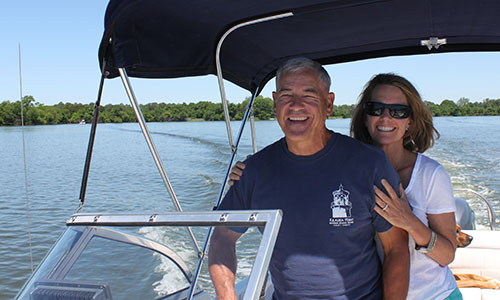
At 78, Jan Greer wanted to stay active and athletic. Herniated disks, stenosis and other degenerative back problems were causing him unbearable pain. When the pain became too much to bear, he turned to Johns Hopkins.
Generally this arthritis of the spine does not hurt or cause symptoms and nothing has to be done. If it does cause symptoms, then treatment depends upon the severity of the symptoms. If the symptoms are only stiffness and soreness, they are treated with heat or ice and a gentle stretching program of the neck. If the pain is not relieved, then medication can help relieve the symptoms until the pain subsides.
There are two types of medicine to start with. The first is acetaminophen, which will help with the discomfort. Arthritis medicines, such as aspirin or aspirin-like medicines (called anti-inflammatories or non-steroidal anti-inflammatory drugs, or NSAIDs), can also be taken. If taking the medicine once or twice a day works, then that is all that is needed. If the pain is more severe, then these medicines should be taken according to the instructions on the bottle. If that does not work, you should contact your doctor for an evaluation and a prescription for stronger medicine.
What can my doctor do about the symptoms?
Treatment depends upon the severity of the symptoms and whether or not there are any signs that the nerves are involved. The doctor will take your history and do an examination of the muscles and nerves in your arms. In some cases an X-ray will be necessary to see if the discs are collapsing or if there are any bone spurs. If it appears that the arthritis of the spine is not too severe and the nerves are not involved, then the physician will give you arthritis medicines and perhaps pain pills to get the irritation under control.
If arthritis medicine is prescribed, it usually has to be taken for several weeks (four to six) to be effective. If the pain is severe and not controlled by the anti-inflammatory medicine, pain pills may be prescribed. In some instances where the neck pain is severe and not helped by the other medicine, cortisone pills for one week may be helpful. The dose of cortisone used is small and typically has none of the side effects of taking prednisone for months (small doses will not thin your bones or make you swell up). If those measures do not work or if there are signs of nerve damage, then more tests may be needed.
What other tests might be done?
he main reason to perform more tests is if the symptoms are getting worse despite treatment, if the pain is severe or if you have signs of nerve damage — particularly nerve damage that is getting worse. The signs of worsening nerve damage would be increasing tingling or numbness, weakness and sometimes increasing pain. If the physician is concerned that you might have a pinched nerve, then the best tests would be an MRI of the neck or occasionally a computed tomography (CT) scan. Another test that can be done to see if the nerves are involved is called an electromyography (EMG) or a nerve conduction study (NCS). In these two tests, a physician uses instruments to evaluate the muscles and nerves to see if they are carrying the signals from the spine to the arms properly. This test can evaluate several different nerves in your arms to see if the nerve is pinched at the neck or at some other place, such as the wrist (a condition called carpal tunnel syndrome).

